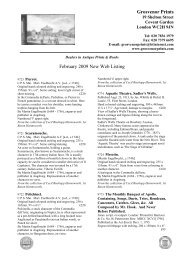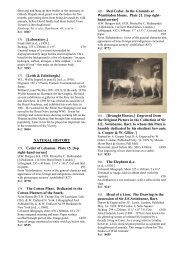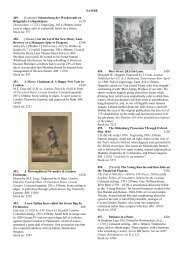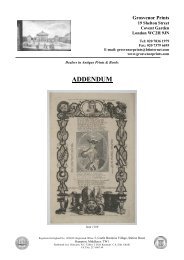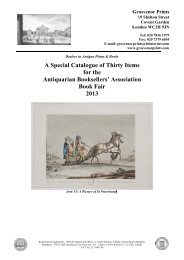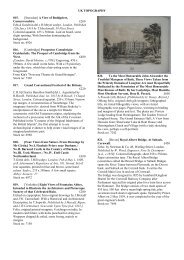Catalogue Part 1.pdf - Grosvenor Prints
Catalogue Part 1.pdf - Grosvenor Prints
Catalogue Part 1.pdf - Grosvenor Prints
Create successful ePaper yourself
Turn your PDF publications into a flip-book with our unique Google optimized e-Paper software.
carriage. Crinoline was originally a stiff fabric with a<br />
weft of horse-hair and a warp of cotton or linen thread.<br />
The fabric first appeared around 1830, but by 1850 the<br />
word had come to mean a stiffened petticoat or rigid<br />
skirt-shaped structure of steel designed to support the<br />
skirts of a woman’s dress in the required shape. The<br />
crinoline was the subject of much ridicule and satire,<br />
particularly in Punch magazine. Dress reformers did<br />
not like it either — they seized upon the cage aspect of<br />
the crinoline and claimed that it effectively imprisoned<br />
women. Given that the crinoline did eventually have a<br />
maximum diameter of up to 180 centimetres (six feet),<br />
it is easy to imagine difficulties in getting through<br />
doors, in and out of carriages, and the general problems<br />
of moving in such a large structure. The second<br />
problem was the potential impropriety of the crinoline.<br />
Its lightness was a curse as well as a blessing, as a gust<br />
of wind or a knock could set it swinging and reveal the<br />
wearer's legs. Even worse, if a woman tripped or was<br />
knocked over, the crinoline would hold her skirts up.<br />
Ref: 8996<br />
240. Crinoline 1858. Brompton.<br />
[T.H. Guerin.] [London, T. Archer.]<br />
Sepia tinted lithograph with colour added by hand,<br />
sheet 300 x 405mm. 11¾ x 16". Trimmed to image top<br />
and sides. £180<br />
A satire on mid 19th century female fashion. A male<br />
passenger enjoys the view as a female carriage driver's<br />
skirt is blown upwards. Crinoline was originally a stiff<br />
fabric with a weft of horse-hair and a warp of cotton or<br />
linen thread. The fabric first appeared around 1830, but<br />
by 1850 the word had come to mean a stiffened<br />
petticoat or rigid skirt-shaped structure of steel<br />
designed to support the skirts of a woman’s dress in the<br />
required shape. The crinoline was the subject of much<br />
ridicule and satire, particularly in Punch magazine.<br />
Dress reformers did not like it either — they seized<br />
upon the cage aspect of the crinoline and claimed that<br />
it effectively imprisoned women. Given that the<br />
crinoline did eventually have a maximum diameter of<br />
up to 180 centimetres (six feet), it is easy to imagine<br />
difficulties in getting through doors, in and out of<br />
carriages, and the general problems of moving in such<br />
a large structure. The second problem was the potential<br />
impropriety of the crinoline. Its lightness was a curse<br />
as well as a blessing, as a gust of wind or a knock<br />
could set it swinging and reveal the wearer's legs. Even<br />
worse, if a woman tripped or was knocked over, the<br />
crinoline would hold her skirts up.<br />
Ref: 8993<br />
241. [The Thames and the Embankment<br />
looking east, with a view of St. Paul's.]<br />
Rowland Langmaid [signed in pencil lower right.] [n.d.<br />
c.1920.]<br />
Etching. 295 x 230mm. 11½ x 9". £320<br />
A pupil of W L Wyllie, Rowland Langmaid (1897 -<br />
1956) served in the Royal Navy; He exhibited at the<br />
R.A.<br />
'Proof' blindstamp lower left.<br />
Ref: 8629<br />
242. The Tower & Preparation of the Fire<br />
Works, with the Balloon, In the Park<br />
Aug.t. 1st. 1814.<br />
J.H. Clark Del. M. Dubourg Sculpt. Published & Sold<br />
Aug.t 12.th 1814 by EDW.D ORME, Publisher to his<br />
Majesty and H.R.H. the Prince Regent, Bond Street,<br />
/corner of Brook Str./ London<br />
Coloured aquatint, print area 200 x 290mm. £120<br />
On Monday, August 1st 1814, a national jubilee took<br />
place to celebrate the return of peace. In the early part<br />
of the evening James Sadler, the first English<br />
balloonist, ascended in his balloon from the space in<br />
front of Buckingham House, after which a two hour<br />
firework display took place in Green Park.<br />
Ref: 8193<br />
243. St. Bride's Avenue. The<br />
Improvement in Fleet Street, Proposed To<br />
Be Erected By Voluntary Subscription,<br />
1825. The Committee [a list of members'<br />
names follows in three columns below].<br />
The Public are respectfully informed that<br />
the Work is commenced and will be<br />
completed with all convenient speed. Early<br />
Contributions are requested in support of<br />
an Improvement so conducive to the<br />
general Embellishment of the Metropolis.<br />
John B. Papworth, Archt. Thos. Kearnan, Sculpt.<br />
Published by R. Ackermann, 101, Strand, Jany. 28th.<br />
1825.<br />
Engraving, outline proof with open letters, 505 x<br />
330mm. £260<br />
View of St Brides Avenue as seen from fleet street,<br />
with figures and adjacent shop fronts, including the<br />
premises of Pitman and Ashfield to the left.<br />
John Buonarroti Papworth (1775 - 1847), architect and<br />
designer, was a thorough master of drawing<br />
perspective and classic ornament. Many of his<br />
architectural designs were exhibited at the Royal<br />
Academy yearly from 1794 to 1799. For the premises<br />
of Rudolf Ackermann, the publisher of this engraving,<br />
to whose ‘Repository of Arts and Essays’ from 1809 to<br />
1823 he was a frequent contributor of prose and verse<br />
and of drawings, he designed a hall or reception-room,<br />
intended as a lounge for customers. In 1826 he worked<br />
on the extensive building, No. 96 Strand, at the corner




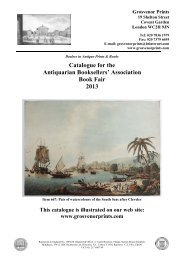
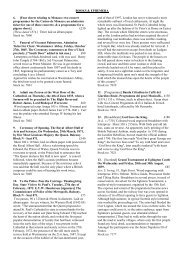
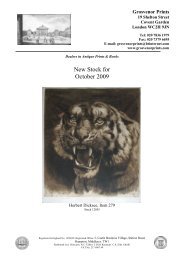
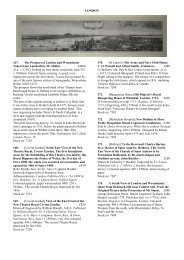
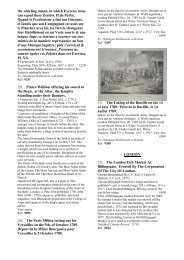
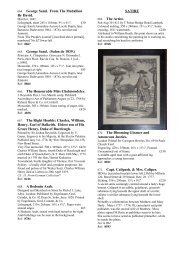
![FOREIGN TOPOGRAPHY 661. [Niagara] The ... - Grosvenor Prints](https://img.yumpu.com/38432042/1/184x260/foreign-topography-661-niagara-the-grosvenor-prints.jpg?quality=85)
